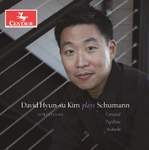|
Back
02/02/2022
Robert Schumann: Papillons, opus 2 – Carnaval, opus 9 – Arabeske, opus 18
David Hyun-su Kim (piano)
Recording: Chism Recital Hall, Whitman College, Walla Walla, Washington (May 28-31, 2019) – 60’14
Centaur CRC 3877 – Booklet in English

   
In a new, endlessly fascinating recording, David Hyun-su Kim, fortepianist, plays three of Schumann’s most beloved compositions on a modern replica of a Graf piano. Graf pianos date from the time of Mozart and Haydn, were played by Beethoven and later composers. The instrument on this album was built by R.J. Regier of Freeport, Maine in 2013 to replicate as closely as possible the kind of Graf played by Schumann and his wife (pianist and composer Clara Wieck Schumann) in the early 1830s.
The 6-1/2 octave Graf replica delivers more than a historically informed performance. Under Kim’s touch, the instrument reveals fresh insights into the complex world of Robert Schumann’s musical thought. Thanks to the subtle mechanical adjustments employed by the piano maker as well as Kim’s nuanced phrasing and articulations, this familiar music yields an unexpected depth and, in places, a sheer beauty that is unrivaled by performances on modern instruments. This is accomplished, in part, through the action of four pedals: (from the bass) keyboard shift, moderator, bassoon, damper. In particular, the keyboard shift permits feathering from three to two to one string. Information about fortepianos is abundant online, including the manufacturer of this replica, whose website is rjregierfortepianos.com.
The album begins with the tender Papillons (Butterflies), opus 2, inspired by a book, Flegeljahre (The Awkward Age, or Years of Indiscretion) by Schumann’s favorite novelist, Jean Paul. Schumann is reported to have said that the work describes, in tones, the final chapter of the book, which concludes with a masked ball.
Kim takes advantage of the instrument’s responsiveness and less voluminous tone to produce phrases that are soft and gentle, yet precise. In this recording, the 12 brief movements are strung together like gemstones on a strand of silk. While not individually identified in the accompanying booklet notes, the curious listener may find their titles and approximately lengths via an online search. I sat beside a (modern) piano as I listened and was able to identify which movement was which by a combination of finding the key and matching it to the movement’s description or tempo (e.g., n° 9, “Waltz Prestissimo”, B-Flat minor).
Of course, one need not take either approach and may simply listen to music from a unique instrument as well as Kim’s thoughtful phrasing and 19th-century disregard for strict observance of time. Throughout, to listen is to be mesmerized by the discreetly applied sustain pedal, noticeable only as the performing artist decides to apply its effect. Delicate grace notes and rolls that sound as though sighed by a Spanish guitar also add freshness to this performance of familiar favorites.
Carnaval, opus 9, tells another tale in tones, this time portraying an array of not only masked-ball characters, but also the musical warriors who would do battle against the cultural Philistines of Schumann’s time. These artistic soldiers became known as the Davidsbündler (League of David, referring to the biblical shepherd who defeated the Philistines in ancient Israel). The Philistines who provoked Schumann’s wrath were none other than popular theater composers of his time (e.g., Rossini) and even the occasional misled conductor (e.g., Richard Wagner). Schumann acknowledges some of these warriors by name or pseudonym: Chopin earns the loveliest melody which has seldom before been performed with such shimmering beauty. Smart and elegant, Clara Wieck, soon to become a Schumann, shines in a movement titled, “Chiarina.”
Kim’s delineation of each character is crisp and distinctive, as he employs rubatos that are subtle yet full of romantic feeling (see the “Florestan” movement). The performances on this album are not overtly passion-filled or smothered in crashing chords, yet passion and power are suggested, perhaps implied.
In the concluding work, Arabeske, opus 18, Kim applies the sustain pedal only as needed, creating a halo effect when emphasizing certain sections or phrases. Halo upon halo they rise, like the rings of Saturn, or even Jupiter with its swirling crimson clouds. We will want to continue to listen to Schumann on modern instruments, but there is no doubt that Kim’s interpretation, on an instrument that may closely replicate one Schumann himself used and heard, is an essential part of our understanding of this composer, the musical world in which he lived, and the joy of experiencing compositions and playing of the highest order.
Linda Holt
|